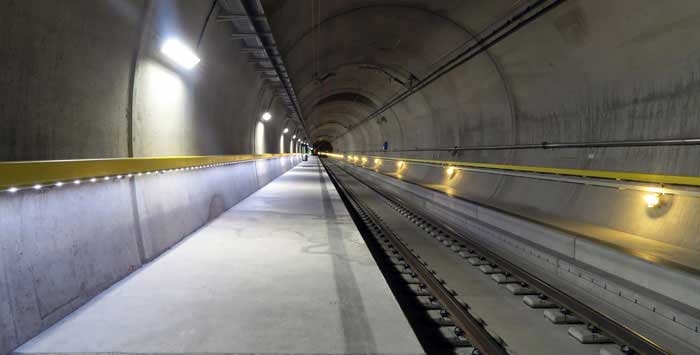The Gotthard Base Tunnel, billed as Switzerland's “construction of the century”, is the world's longest, deepest tunnel. It took seventeen years to build this tunnel that goes deep beneath the Swiss Alps.
The 57-kilometer (35-mile long) tunnel will provide a high-speed rail link - that goes under the well-known mountain range - between northern and southern Europe.
The tunnel has overtaken Japan's 53.9km Seikan rail tunnel as the longest in the world and pushed the 50.5km Channel Tunnel that connects the UK and France into third place.
Swiss Federal President Johann Schneider-Ammann said it was a “giant step for Switzerland but equally for our neighbours and the rest of the continent”.
The last French President Francois Hollande compared the Gotthard to the Channel Tunnel, which was completed in 1994. He said: “Nobody could have imagined that one day you would be able to travel from England to France in that way. Since then we are more united than ever and I hope the British will remember that when the day comes,” referring to the referendum the UK holds to decide whether or not to remain in the EU. Now the suprise and shocking Britexit vote has past it's seems that open travel is the only way to cooperate in the Globalized world of today as walls and borders reduce International Cooperation.
The project, which cost $12bn to build was approved by Swiss voters in a referendum in 1992. Then voters supported a proposal from environmental groups to move all freight travelling through Switzerland from road to rail two years later.
The project was a challenge to build. Engineers had to dig and blast through 73 different kinds of rock, some as hard as granite and others as soft as sugar. After excavating 28m tonnes of rock, this was broken down to help make the concrete used to build the tunnel.
The tunnel provides a mainline rail connection between Rotterdam in the Netherlands and Genoa in Italy. It also reduces the journey time for travellers by an hour to two hours and 40 minutes.
The tunnel's course is flat and straight and about 260 freight trains and 65 passenger trains will pass through the tunnel each day in a journey that can take as little as 17 minutes.
The tunnel is being financed by value-added and fuel taxes, road changes on heavy vehicles and state loans that are due to be repaid within a decade. According to the Swiss bank Credit Suisse, its economic benefits will include the easier movement of goods and increased tourism.
It is expected the economic benefits of increased trade and travel efficiency will make inroads into the tunnel's $12 billion construction cost.
The tunnel is expected to bring significant environmental benefits by diverting freight sent by road on to rail instead. “The main reason for the construction of this tunnel was to get the goods traffic off the motorway and onto the trains,” Simon Peggs of AlpTransit Gotthard stated. “It's just getting more and more (busy) every year and it was estimated that by 2020, the roads will be so blocked that something had to be done.”
For those who enjoy the scenic views of the Alpine route, there is no reason to panic. Even though the new tunnel bypasses the scenic original Gotthard line but this line, popular with tourists for its panoramic views as it winds through the mountain range, crossing 205 bridges in the process, will continue to operate.

